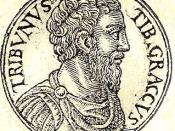Outside on the Statehouse lawn, there is a statue bearing the inscription "These Are My Jewels" portraying a women, her arms outstretched over several great men from Ohio. Perhaps no woman better represented the archetype of the ideal Roman wife than Cornelia.
Cornelia was the daughter of the hero Publius Scipio Africanus, who defeated Hannibal in the second Punic War. She was married to patrician cousin Tiberius Sempronius Gracchus and was mother to twelve children. Only three lived to adulthood: a daughter, Sempronia, and two sons, Tiberius and Gaius Gracchus. After her husband's death, Cornelia devoted herself to raising her three young children in the highest patrician traditions of service to the state. She was never remarried, which is an example of the Roman ideal of a widow never remarrying out of loyalty to her first husband.
She was also a modest woman during a time of flamboyant displays of wealth in Rome.
A noble Roman lady once asked her to show her ornaments, after she had displayed her own. Cornelia called her boys and said, "These are my jewels!"
On another occasion, some people were speaking of her father and of all he had done, and were congratulating her upon being the daughter of so great a man. Cornelia, however, replied that she was prouder of being called the mother of Tiberius and Gaius Gracchus.
Her influence on both her sons was considerable even after their political careers made them the lightning rods of reform in the late Republic. She would survive the tragedy of losing both sons to political murder.
Plutarch in Life of Gaius Gracchus (19) wrote of her dignified manor after her sons' murders:
Cornelia is said to have borne her misfortunes in a noble and magnanimous spirit, and to have said of the sacred...


